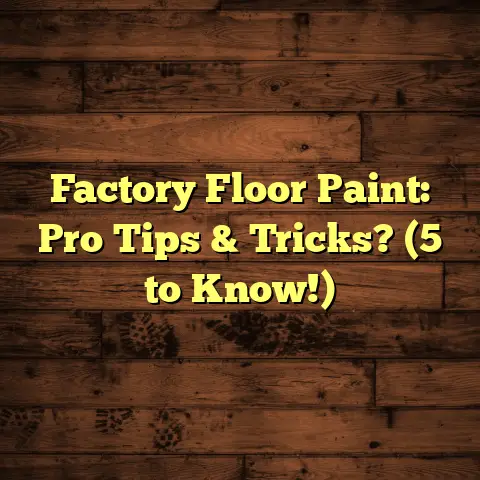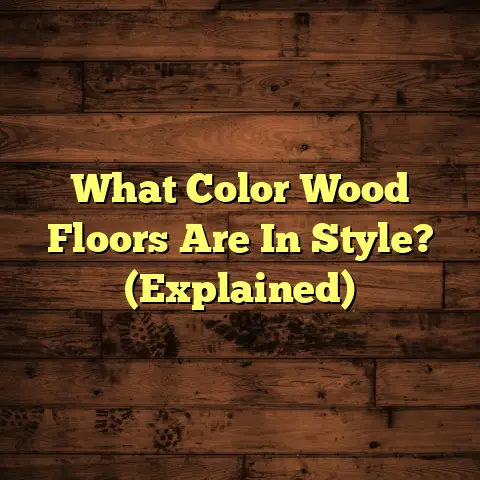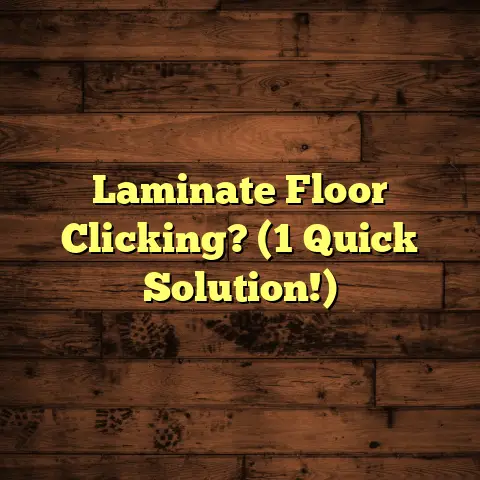Vapor Barrier for Vinyl Plank on Concrete? (2 Musts!)
Flooring, to me, is more than just something you walk on.
It’s the canvas of your home, the foundation upon which you build your life.
Think about it – it sets the tone, defines the space, and quietly contributes to the overall aesthetic.
Over the years, I’ve seen flooring materials evolve from simple wood planks to the incredible variety we have today.
And vinyl plank flooring?
It’s a game-changer!
It combines style, durability, and a touch of practicality that makes it perfect for modern living.
But here’s the thing: even the best flooring can fail if it’s not installed correctly.
Especially when you’re dealing with concrete subfloors.
That’s where vapor barriers come in.
They’re the unsung heroes that protect your investment and ensure your vinyl plank flooring lasts for years to come.
So, let’s dive into the world of vapor barriers and why they are absolutely essential when installing vinyl plank on concrete.
Trust me, understanding this can save you a lot of headaches (and money) down the road!
Section 1: Understanding Vapor Barriers
1. Definition and Purpose
Okay, so what exactly is a vapor barrier?
Simply put, it’s a material designed to prevent moisture from passing through it.
In flooring, it’s typically a thin sheet of plastic or a specialized membrane installed between the concrete subfloor and the flooring material.
Its primary function is to block moisture that rises from the concrete, preventing it from reaching your beautiful vinyl plank.
Why is this important?
Well, moisture can cause all sorts of problems, like:
-
Mold and Mildew: Nobody wants that!
-
Warping: Your planks can start to buckle and look uneven.
-
Adhesive Failure: The glue holding your flooring down can weaken, leading to loose planks.
Think of it like this: your concrete floor is constantly breathing, releasing moisture.
A vapor barrier is like a raincoat for your flooring, keeping it dry and protected.
2. Materials and Types
Now, let’s talk materials.
The most common type of vapor barrier I use is polyethylene sheeting, often referred to as “poly.” It’s readily available, relatively inexpensive, and does a great job when installed correctly.
Here’s a quick rundown:
Thickness: Typically measured in mils (thousandths of an inch).
I usually recommend a minimum of 6-mil polyethylene for most residential applications.
For areas with high moisture, like basements, I might even go thicker.Permeability: This refers to how much moisture can pass through the material.
You want a low permeability rating for a vapor barrier.
Look for materials with a perm rating of 1 or less.
(A perm is a unit of measurement for water vapor permeance.)Other Options: Some manufacturers offer specialized vapor barrier membranes with enhanced features like antimicrobial properties or self-adhesive backing.
These can be a good choice for specific situations, but they’re generally more expensive.
3. Moisture and Concrete
Concrete is like a giant sponge.
It’s porous, meaning it has tiny holes that allow it to absorb and retain moisture.
This moisture can come from several sources:
-
Groundwater: Moisture from the soil beneath the concrete slab.
-
Rainfall: Water seeping through cracks or porous areas.
-
Humidity: Moisture in the air condensing on the cool concrete surface.
Without a vapor barrier, this moisture will migrate upwards through the concrete and into your vinyl plank flooring.
And trust me, that’s a recipe for disaster.
The Portland Cement Association provides excellent resources on understanding moisture in concrete.
You can find more information on their website (I can’t provide a direct link, but a quick search will do the trick!).
Section 2: The Importance of Vapor Barriers for Vinyl Plank Flooring
1. Protecting the Investment
Let’s be real, flooring is a significant investment.
You spend time researching, choosing the perfect style, and paying for installation.
A vapor barrier is a small price to pay to protect that investment.
Think of it as insurance.
You hope you never need it, but you’re sure glad you have it when something goes wrong.
A vapor barrier ensures that your vinyl plank flooring maintains its structural integrity and visual appeal for years to come.
2. Preventing Damage
I’ve seen firsthand what happens when vapor barriers are skipped or improperly installed.
It’s not pretty.
Here are some of the damages you might encounter:
-
Buckling and Warping: Moisture causes the planks to expand and contract unevenly, leading to buckling and warping.
-
Mold and Mildew Growth: Damp environments are breeding grounds for mold and mildew, which can be harmful to your health and cause unpleasant odors.
-
Adhesive Failure: Moisture can weaken the adhesive, causing the planks to lift or become loose.
-
Seam Separation: The seams between planks can start to separate, creating unsightly gaps and tripping hazards.
I once worked on a project where the homeowner decided to skip the vapor barrier to save a few bucks.
Within a year, their brand-new vinyl plank floor was riddled with mold and the planks were starting to buckle.
They ended up having to rip up the entire floor and start over, costing them way more than the original vapor barrier would have.
According to a study by the National Association of Home Builders (NAHB), moisture-related problems are a leading cause of flooring failures (again, I can’t provide a direct link, but you can find this information with a quick search).
3. Long-Term Benefits
Installing a vapor barrier isn’t just about preventing immediate damage.
It also provides several long-term benefits:
-
Reduced Maintenance Costs: By preventing moisture damage, you’ll spend less time and money on repairs and replacements.
-
Extended Lifespan of Flooring: A properly installed vapor barrier can significantly extend the lifespan of your vinyl plank flooring.
-
Improved Indoor Air Quality: By preventing mold and mildew growth, you’ll create a healthier living environment for you and your family.
-
Increased Home Value: A well-maintained home with quality flooring is always more appealing to potential buyers.
Section 3: Essential Considerations for Installing a Vapor Barrier with Vinyl Plank on Concrete
Alright, let’s get down to the nitty-gritty.
Here are the two “musts” you need to know when installing a vapor barrier with vinyl plank on concrete:
1. The First Must: Correct Installation Techniques
This is where attention to detail is key.
You can have the best vapor barrier on the market, but if it’s not installed correctly, it won’t do its job.
Here’s a step-by-step guide:
Prepare the Subfloor: Ensure the concrete is clean, dry, and level.
Fill any cracks or imperfections with a concrete patch.
I always recommend testing the moisture level of the concrete using a moisture meter.
You want to make sure it’s within the acceptable range recommended by the vinyl plank manufacturer.Measure and Cut: Measure the area you need to cover and cut the vapor barrier material to size.
I always add a few extra inches on each side for overlapping.Lay Down the Vapor Barrier: Unroll the vapor barrier and lay it flat on the concrete.
Make sure it’s smooth and wrinkle-free.Overlap the Seams: Overlap the seams by at least 6 inches.
This is crucial to prevent moisture from seeping through.Seal the Seams: Use a high-quality seam tape specifically designed for vapor barriers to seal the seams.
Press the tape firmly to ensure a tight seal.
I prefer using a pressure roller for this step.Seal the Edges: Seal the edges of the vapor barrier to the walls using the same seam tape.
This creates a continuous barrier that prevents moisture from entering from the sides.Inspect and Repair: Carefully inspect the entire vapor barrier for any tears or punctures.
Repair any damage with seam tape.
Pro Tip: When working with polyethylene sheeting, it can be helpful to use weights or tape to hold it in place while you’re working.
2. The Second Must: Choosing the Right Type of Vapor Barrier
Not all vapor barriers are created equal.
You need to choose the right type based on your specific situation:
-
Climate: In humid climates, you’ll need a more robust vapor barrier with a lower permeability rating.
Type of Vinyl Plank: Some vinyl plank flooring has a built-in vapor barrier.
In this case, you may not need to install a separate one.
Always check the manufacturer’s recommendations.Installation Scenario: Basements and ground floors are more susceptible to moisture than upper floors.
You’ll need a thicker vapor barrier for these areas.-
Existing Moisture Levels: If you’re dealing with a concrete slab that has high moisture levels, you may need to consider a more specialized vapor barrier or even a moisture mitigation system.
Industry Standards and Recommendations:
The American Society for Testing and Materials (ASTM) has standards for vapor retarders used in building construction.
Refer to ASTM E96 for testing methods and performance criteria.-
Always check the vinyl plank manufacturer’s recommendations for vapor barrier requirements.
-
Consult with a flooring professional to determine the best vapor barrier for your specific needs.
Section 4: Common Myths and Misconceptions
Let’s bust some myths!
I’ve heard all sorts of misconceptions about vapor barriers over the years.
Here are a few of the most common:
1. Debunking Myths
Myth: “I don’t need a vapor barrier because my concrete is new.”
- Reality: Even new concrete can contain moisture.
A vapor barrier is always a good idea.
- Reality: Even new concrete can contain moisture.
-
Myth: “I live in a dry climate, so I don’t need a vapor barrier.”
- Reality: Even in dry climates, concrete can absorb moisture from the ground.
Myth: “My vinyl plank is waterproof, so I don’t need a vapor barrier.”
- Reality: While vinyl plank is water-resistant, it’s not impervious to moisture damage.
A vapor barrier protects the flooring from moisture rising from the concrete.
- Reality: While vinyl plank is water-resistant, it’s not impervious to moisture damage.
2. Clarifying Misconceptions
One of the biggest misconceptions is that vinyl plank is completely waterproof and therefore doesn’t need any additional protection.
While vinyl is certainly more water-resistant than many other flooring options, it’s not a foolproof shield against moisture.
Think of it like this: a raincoat will keep you dry in a light drizzle, but if you’re standing in a downpour for hours, you’re eventually going to get wet.
Similarly, vinyl plank can handle spills and splashes, but it can’t withstand constant exposure to moisture rising from the concrete.
That’s where the vapor barrier comes in.
It acts as a second line of defense, preventing moisture from reaching the vinyl and causing damage.
Section 5: Case Studies and Real-Life Examples
Let’s bring this all together with some real-life examples.
1. Successful Installations
I recently completed a project where we installed vinyl plank flooring in a basement.
We took the time to properly prepare the subfloor, install a high-quality vapor barrier, and seal all the seams and edges.
The result?
A beautiful, durable floor that the homeowners will enjoy for years to come.
I’ve also worked on projects where we skipped the vapor barrier because the homeowners were trying to save money.
Inevitably, those floors ended up with moisture problems, leading to costly repairs and replacements.
2. Lessons Learned
One of the most valuable lessons I’ve learned over the years is that cutting corners on flooring installation is never a good idea.
A properly installed vapor barrier is a small investment that can save you a lot of money and headaches in the long run.
I remember one project where we used a cheap, low-quality vapor barrier.
Within a few months, the seams started to fail, allowing moisture to seep through.
We ended up having to rip up the entire floor and start over with a better vapor barrier.
The lesson? Always use high-quality materials and follow proper installation techniques.
Conclusion: The Art of Flooring Protection
So, there you have it!
Vapor barriers for vinyl plank on concrete: 2 musts!
Flooring is more than just a surface; it’s an art form.
It’s about creating a space that’s both beautiful and functional.
By understanding the importance of vapor barriers and following proper installation techniques, you can protect your investment and ensure that your vinyl plank flooring lasts for years to come.
Don’t just think of flooring as a functional element – think of it as an artistic expression.
By using the right materials and methods, you can create a space that’s both beautiful and durable.





